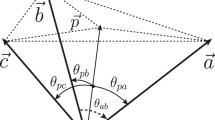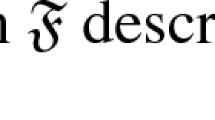Abstract
We show that partial transposition for pure and mixed two-particle states in a discrete N-dimensional Hilbert space is equivalent to a change in sign of a “momentum-like” variable of one of the particles in the Wigner function for the state. This generalizes a result obtained for continuous-variable systems to the discrete-variable system case. We show that, in principle, quantum mechanics allows measuring the expectation value of an observable in a partially transposed state, in spite of the fact that the latter may not be a physical state. We illustrate this result with the example of an “isotropic state”, which is dependent on a parameter r, and an operator whose variance becomes negative for the partially transposed state for certain values of r; for such rs, the original states are entangled.
Similar content being viewed by others
References
Steane, A.: Quantum computing. Rep. Prog. Phys. 61, 117 (1998)
Band, Y.B., Avishai, Y.: Quantum Mechanics with Applications to Nanotechnology and Information Science. Academic Press (Elsevier), Oxford (2013)
Horodecki, M.L.: Entanglement measures. Quantum Inf. Comput. 1, 3 (2001)
Plenio, M.B., Virmani, S.: An introduction to entanglement measures. Quantum Inf. Comput. 7, 1 (2007)
Peres, A.: Separability criterion for density matrices. Phys. Rev. Lett. 77, 1413 (1996)
Horodecki, P.: Separability criterion and inseparable mixed states with positive partial transposition. Phys. Lett. A 232, 333 (1997)
Horodecki, M., Horodecki, P., Horodecki, R.: Mixed-state entanglement and distillation: is there a ”bound” entanglement in Nature? Phys. Rev. Lett. 80, 5239 (1998)
Simon, R.: Peres-Horodecki separability criterion for continuous variable systems. Phys. Rev. Lett. 84, 2726 (2000)
Werner, R.F., Wolf, M.M.: Bound entangled Gaussian states. Phys. Rev. Lett. 86, 3658 (2001)
Braunstein, S.L., van Loock, P.: Quantum information with continuous variables. Rev. Mod. Phys. 77, 513 (2005)
Mello, P.A., Revzen, M.: Wigner function and successive measurements of position and momentum. Phys. Rev. A 89, 012106 (2014)
Mann, A., Mello, P.A., Revzen, M.: A family of Weyl–Wigner transforms for discrete variables defined in a finite-dimensional Hilbert space. Quantum Stud. Math. Found. 4, 89 (2017)
Gross, D.: Hudson’s theorem for finite-dimensional quantum systems. J. Math. Phys. 47, 122107 (2006)
Gross, D.: Diploma Thesis: Finite Phase Space Methods in Quantum Information. University of Potsdam, Berlin (2005)
Revzen, M.: Radon transform in finite Hilbert space. Europhys. Lett. 98, 10001 (2012)
de la Torre, A.C., Goyeneche, D.: Quantum mechanics in finite-dimensional Hilbert space. Am. J. Phys. 71, 49 (2003)
Schwinger, J.: Unitary Operator Bases. Proc. Natl. Acad. Sci. USA 46, 570 (1960)
Schwinger, J.: Unitary transformations and the action principle. Proc. Natl. Acad. Sci. USA 46, 883 (1960)
Durt, T., Englert, B.-G., Bebgtsson, I., Zyczkowski, K.: On mutually unbiased bases. Int. J. Quantum Inf. 8, 535 (2010)
Wootters, W.K.: A Wigner-function formulation of finite-state quantum mechanics. Ann. Phys. (N.Y.) 176, 1 (1987)
Wootters, W.K., Fields, B.D.: Optimal state-determination by mutually unbiased measurements. Ann. Phys. (N.Y.) 191, 363 (1989)
Ivanovic, I.D.: Geometrical description of quantum state determination. J. Phys. A 14, 3241 (1981)
Vidal, G., Werner, R.F.: Computable measure of entanglement. Phys. Rev. A 65, 032314 (2002)
Arunachalam, S., Johnston, N., Russo, V.: Is absolute separability determined by the partial transpose? arXiv:1405.5853v3 [quant-ph] (2015)
Acknowledgements
PAM acknowledges support by DGAPA, under Contract No. IN109014; he is also grateful to the Ben-Gurion University, Beer Sheva, Israel, where this research was started, for its kind hospitality. YBB acknowledges support from the DFG through the DIP program (FO703/2-1).
Author information
Authors and Affiliations
Corresponding author
Appendices
A Schwinger operators for one particle
We consider an N-dimensional Hilbert space spanned by N distinct states \(|q\rangle \), with \(q=0,1, \ldots ,(N-1)\), which are subject to the periodic condition \(|q+N\rangle =|q\rangle \). These states are designated as the “reference basis” of the space. We follow Schwinger [17, 18] and introduce the unitary operators \({\hat{X}}\) and \({\hat{Z}}\), defined by their action on the states of the reference basis by the equations:
The operators \({\hat{X}}\) and \({\hat{Z}}\) fulfill the periodicity condition:
\(\hat{{\mathbb {I}}}\) being the unit operator. These definitions lead to the commutation relation:
The two operators \({\hat{Z}}\) and \({\hat{X}}\) form a complete algebraic set, in that only a multiple of the identity commutes with both [17, 18]. As a consequence, any operator defined in our N-dimensional Hilbert space can be written as a function of \({\hat{Z}}\) and \({\hat{X}}\). We also introduce (i.e., define) the Hermitian operators \({\hat{p}}\) and \({\hat{q}}\), which play the role of “momentum” and “position”, through the equations [16, 19]:
What we defined as the reference basis can thus be considered as the “position basis”. With (63) and definitions (64), (65), the commutator of \({\hat{q}}\) and \({\hat{p}}\) in the continuous limit [16, 19] is the standard one, \([{\hat{q}},{\hat{p}}]=i\).
B Proof of Eq. (3)
The joint probability distribution of the two momenta \(p_1, p_2\) in the state \({\hat{\rho }}\) is given by
The joint probability distribution of the two momenta \(p_1, p_2\) for the PT operator \({\hat{\rho }}^{T_1}\) is given by
This proves Eq. (3). The above proof applies for \(N>2\), since, for \(N=2\), \(| p\rangle = |-p\rangle \).
For the case of only one particle, the above result reduces to that of Eq. (1).
C Proof of Eqs. (2) and (4)
We define the Wigner function for the density operator \({\hat{\rho }}\) as in Ref. [12], as
where \({\hat{P}}_{q_i p_i}\) is the “line operator” for particle i, also defined in the above reference. Explicitly, we find
By definition, the Wigner function after \(\hbox {PT}_{1}\) is then
This proves Eq. (4).
For the case of only one particle, the above result reduces to that of Eq. (2).
D Proof of Eqs. (56), (57), and (58)
From the properties of one-particle Schwinger operators summarized in Appendix A, one can prove the following identities:
We write the PT of the state of Eq. (47) as
For the first moment of \({\hat{{\varOmega }}}\), we then find
We used the identity (78) to obtain Eq. (83). Equations (82) and (83) are used to prove Eq. (56) in the text.
For the second moment of \({\hat{{\varOmega }}}\), we have
To obtain Eq. (85), we made use of the identity (79), and to obtain Eq. (86), we made use of the identity (78). Equations (85) and (86) are used to prove Eq. (57) in the text.
Rights and permissions
About this article
Cite this article
Band, Y.B., Mello, P.A. Partial transposition in a finite-dimensional Hilbert space: physical interpretation, measurement of observables, and entanglement. Quantum Stud.: Math. Found. 5, 177–188 (2018). https://doi.org/10.1007/s40509-017-0120-3
Received:
Accepted:
Published:
Issue Date:
DOI: https://doi.org/10.1007/s40509-017-0120-3




